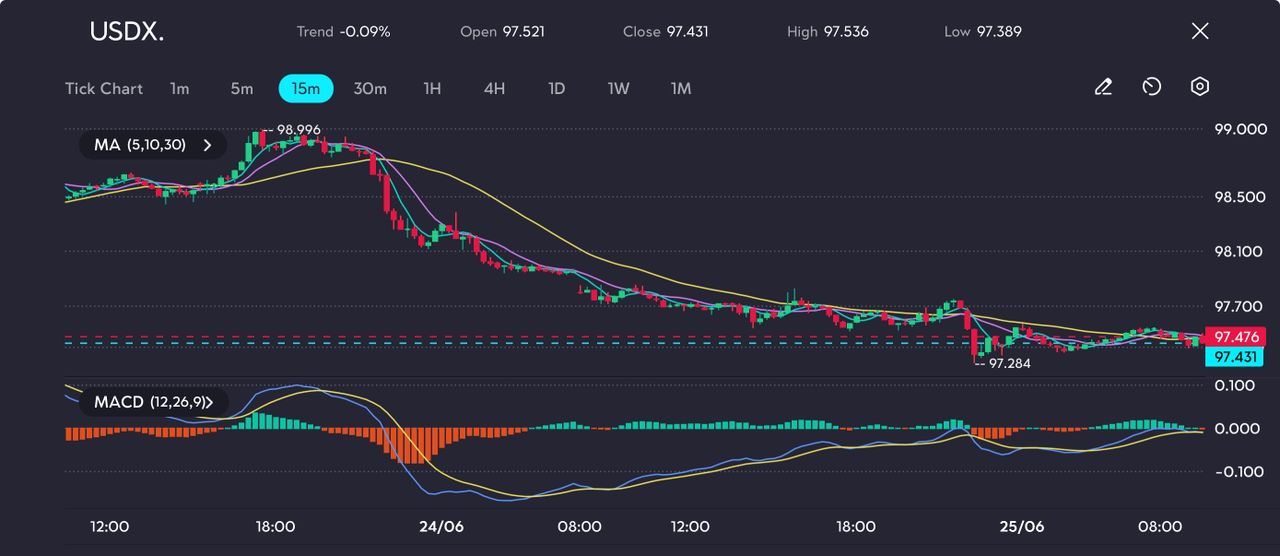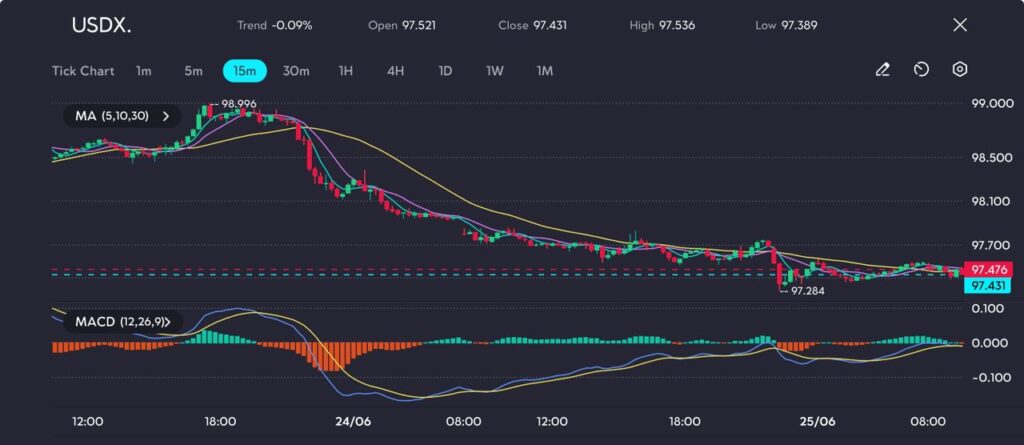US Dollar Index trends down near 97.65 following Israel-Iran ceasefire
Gold prices fall as investors move away from safe assets amid de-escalation in Middle East conflict and Powell’s comments.
Credible journalist Charles Gasparino suggests that the White House may announce trade deals soon.
Deputy Governor Ramsden states that quicker rate cuts may happen if inflation evidence shows weakness.
Less Worry About Disinflation
Ramsden is less concerned than some of his colleagues about disinflation slowing down. Meanwhile, the GBP/USD showed strong daily increases, reaching its highest point since February 2022, trading above 1.3630. His comments suggest that the Bank’s policy may shift soon. If inflation continues to fall below expectations, we might see earlier rate cuts. Markets should view this as a real signal, not just talk. While headline numbers show softer price pressures, we still need to watch underlying core inflation closely. If these weaker trends continue throughout the summer, policy changes could happen sooner than expected. He pointed out the ongoing uncertainty surrounding the UK’s economic recovery, especially considering past supply shocks and weak consumer spending. For those of us observing the rates market, this highlights the need to prepare for a variety of outcomes. Simply expecting a smooth path toward target inflation may overlook the risk of sudden central bank changes.Interest Rates Outlook and Market Response
In fixed income, long-term gilts have followed trends primarily influenced by the US. Since April, 30-year yields have risen, largely based on changes in US Treasury expectations, not necessarily due to local inflation changes. This calls for caution. If UK factors start to diverge from US influences, these instruments may react more to domestic data surprises. Thus, it’s crucial to closely monitor any differences between UK and US rate trends. Ramsden’s stance, which is more relaxed about disinflation risks than some peers, could gain support if CPI reports continue on this path. This isn’t a push for aggressive changes, but the direction is becoming clearer. What was once speculative is taking shape—though volatility is still a near-term concern. The currency markets show increasing confidence in the UK’s fundamentals, with GBP/USD rising to levels not seen since early 2022. While partly due to USD weakness, the pound’s upward momentum indicates that investors are reassessing sterling based on the changing rate outlook. Therefore, currency-sensitive positions may benefit from tighter hedging in the near term, especially if further unwinding of dollar positions leads to more pound appreciation. For those involved in derivatives trading, the shifting rate outlook creates significant turning points. Forward curves, which had been predicting a slow easing, may need to steepen if data continues to come in lower than expected. Implied volatility could rise as the market adjusts its timing expectations. It’s a changing environment, and our strategy must consider both incoming data and shifts in policymakers’ tone. It is crucial to base our strategies on scenario planning. Expecting a smooth path is no longer sufficient. Surprises will continue to present both opportunities and risks in uneven ways, so a more flexible approach may be necessary in the coming weeks. Create your live VT Markets account and start trading now.Jerome Powell discusses the Semi-Annual Monetary Policy Report with the House Financial Services Committee
Market Reaction to Powell’s Testimony
The market reacted noticeably to Powell’s testimony, with the US Dollar Index falling by 0.3%. The dollar weakened against major currencies, especially the New Zealand Dollar. Investors are closely watching economic factors like tariff impacts and job market conditions, which are influencing market sentiment and currency values. After Powell spoke, we noticed an immediate shift in currency pairs, particularly a slight but significant drop in the dollar. His hint at possible earlier rate cuts—if the data shows it’s necessary—likely drove this response. Although there’s no sign of a recession now, the suggestion that rates may drop sooner is important and suggests that policymakers are poised to act more quickly than before. Currently, the Federal Reserve hasn’t set a specific timeline for rate adjustments. However, Powell’s comment about inflation softening and a possible downturn in labor metrics offers a clearer view of what could trigger a policy change. This makes upcoming employment reports, core PCE numbers, and CPI data even more important. If these indicators show significant deviations from trends, especially a downturn, it could shift expectations towards a quicker policy change.Impact of Tariffs and Geopolitical Tensions
Powell also discussed tariffs and geopolitical tensions, especially regarding the Middle East. While the outcomes are currently unclear, they could greatly impact future pricing pressures. These factors are no longer background issues but critical elements that can significantly alter expectations. It’s essential to analyze how changes in risk pricing reflect market sensitivity to these factors. From a trading perspective, we’ve already seen movements in G10 currencies, especially the Kiwi, which rose as the dollar declined. This isn’t just speculation; it shows how comments about flexible policy can change market positioning. Traders should now adapt based on what current trends suggest rather than relying on past data. Keep an eye on the short end of the rates market. It’s not just about whether cuts will happen, but how fast and decisively they will come. Derivative traders should monitor implied volatility in short-dated options, especially in foreign exchange and interest rates, since any changes in Fed officials’ tones or data could lead to short-term price movements. It’s clear that pricing pressures aren’t only affected by domestic factors. External events, particularly geopolitical developments, can either strengthen or weaken domestic labor and consumption data. We are closely observing changes in Treasury yields, especially the 2-year yield, as early signs of market repositioning are likely to show up there first. In conclusion, policies are reactive rather than preemptive. Any shifts in incoming data from previous patterns could quickly affect the policy outlook, and the market is ready to respond. The message is clear: stay alert to upcoming data, keep an eye on rate futures markets, and adjust positions regularly based on changing inflation forecasts and global trade expectations. Create your live VT Markets account and start trading now.RBC analysts see a positive outlook for Japan’s equity market, expecting a possible Japan-US trade agreement.
Micron expects a $7 billion increase in DRAM revenue in Q3 due to AI demand.
In June, the Conference Board’s Consumer Confidence Index fell to 93, indicating a decline in US consumer sentiment.
Impact on US Dollar Index
Following this report, the US Dollar Index saw a decline of 0.55%, bringing it down to 97.80. This report includes forward-looking statements that carry risks and uncertainties. It’s important to do thorough research before making any market moves, considering the potential for total investment losses. Understand all risks, losses, and costs tied to investing. Seek professional advice if needed, as this information is not intended as investment guidance. Be cautious when interpreting all data presented. The weaker reading of the US Consumer Confidence Index, which fell from 98.4 to 93 in June, was a data point that markets were closely watching. Although the trend of decline isn’t new and has been developing for months, this rate of drop was more noticeable. With the Present Situation Index at 129.1, it shows that respondents are becoming more realistic about their circumstances. The Expectations Index also slumped again to 69, which is uncomfortably below the 80 mark often linked to recession risks in historical analyses. The survey reveals that many households are adjusting to the reality of reduced purchasing power. While the view on job availability still seems “positive” in isolation, it has worsened for six consecutive months. This mixed message—good yet deteriorating—doesn’t inspire confidence in ongoing consumer demand, making the economic picture look more complicated. As expected, markets reacted swiftly. The US Dollar Index suffered a significant drop, falling 0.55% to 97.80 for the day. It wasn’t just the headline drop that affected sentiment; the overall tone of the report indicated eroding confidence in personal finances and the economy’s short-term direction, which put pressure on speculative positions. Rate expectations are already unstable, and this situation highlights the Fed’s need to manage its outlook for the coming quarters, rather than sticking only to previous policies.Volatility Risk and Market Response
Looking ahead, volatility risk could increase as traders adjust short-term derivatives. The speed of these adjustments may outstrip wider market positioning, especially if options implied volatility starts to correct in light of recent data surprises. We are monitoring the short gamma space closely, as exposure could become tricky if macro risk indicators shift negatively. If consumers’ mindset leads to weaker consumption metrics, reversion trades might be at risk throughout July. Calendar spreads on macro-event dates are already widening, signaling expected shifts. Drops in confidence typically take time to affect earnings and spending data, but adjustments in expectations usually appear early in pricing movements. This is particularly important for those managing basis risk in futures and analyzing skew in equity index options. If realized volatility continues to lag behind implied readings, we could see increased hedging demand as sentiment turns more defensive. While the current data isn’t bleak enough to cause a sudden change in monetary policy, pricing reactions are more influenced by relative perceptions than absolute levels. We are beginning to watch short-end Treasury vol futures for a rise in convexity trades. This segment is usually not a focus for retail but can be very revealing when directional confidence weakens. Lastly, it’s crucial to ensure that derivative strategies, especially those involving leverage or event risk, are stress-tested against this new information. Those who model forward rate expectations should run updated scenarios, especially where consumers’ outlook intersects with projected discount rates. Create your live VT Markets account and start trading now.Dollar Stumbles As Ceasefire Lifts Appetite For Risk

The US dollar extended its losses on Wednesday, unable to recover as global markets embraced risk following news of a fragile ceasefire between Iran and Israel. US President Donald Trump helped broker the deal earlier this week, ending at least temporarily 12 days of aerial conflict.
While the de-escalation in the Middle East offered some relief to investors, economic signals from the United States remain mixed. In his semi-annual testimony to Congress, Federal Reserve Chair Jerome Powell maintained a cautious tone and gave no clear indication of imminent rate cuts.
Markets, however, are moving ahead with their expectations. According to the CME FedWatch Tool, there is now an 18% probability of a rate cut as early as July, with close to 60 basis points of easing anticipated by December. This shift is largely driven by softening consumer sentiment. June data revealed an unexpected decline as American households expressed growing concerns about job prospects.
This dovetails with a broader drop in yields. The two-year Treasury yield slid to a six-week low of 3.7870%, while the benchmark 10-year yield remained subdued at 4.3043%, reflecting weaker policy expectations in the near term.
Technical Analysis
The dollar’s decline continued, settling at 97.43, well below Tuesday’s peak of 98.99. Price action reflects a persistent downtrend, with the greenback struggling to reclaim the 97.70 level. Momentum remains firmly bearish. The MACD is still in negative territory, and all major moving averages are sloping downward with no immediate signs of reversal.

Should upcoming economic data continue to fall short of expectations—and if inflation softens despite the reintroduction of tariffs—the Fed may be compelled to lower interest rates by the third quarter. Such a scenario would likely put additional downward pressure on the dollar, especially against the euro and risk-sensitive currencies.




